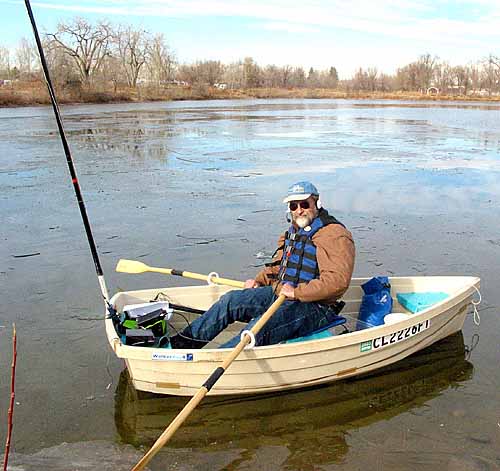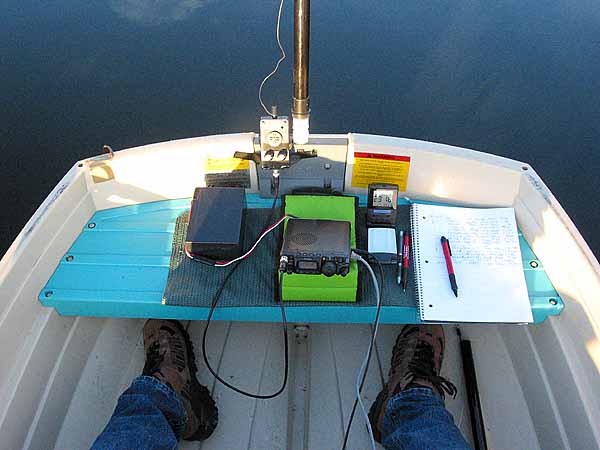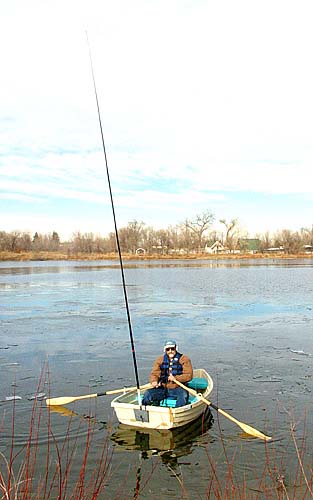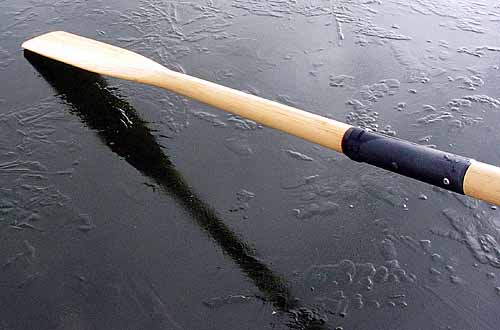I can't think of a better way to bring in the New Year than by being on the water. Even if it is only a half-frozen lake in Colorado.

On December 31, 2003, I set out in my
eight-foot rowboat on a partially frozen lake for what would become an
annual tradition. I had to crunch through a thin layer of ice that
reached about 60 feet from shore before finding open water. That
afternoon I worked into 18 states, Alberta, Ontario, BC and Alberta for
a total 44 QSOs. The radio was the FT-817 at full QRP power and the
antennas were a full-size halfwave wire for 10 meters and a 16-foot
shortened halfwave for 17 meters. Both were supported by a 16.5-foot
fishing pole from Cabelas.com. At 0035Z New Year's Day I finished my
last contact and rowed back to shore in the dark. It was only 5:30 p.m.
local, but with my flashlight I could see the ice beginning to form
where I had broken through earlier so it was time to call it a day. The
temperature was dropping one degree every two minutes, and the ice near
shore was even thicker that before. To get through the ice I lightly
slammed the oar tips down to crack through the ice, then pull back
as the bow crunched its way through. On the final 20 feet before
reaching shore, it required a hard enough hit that the right oar lock
exploded. (They are a hard, white plastic material.) Fortunately I
carry spares.
December 31, 2004 found me repeating my New Year's celebration on the water. I started at 2:00 in the afternoon and was off the water by 0045Z New Year's Day. On this trip I worked into 14 states and Sask., Canada with the 817 and a new, 20-foot shortened end fed halfwave for 17 and 20 meters and working both bands. I have been fortunate that the weather has cooperated two years in a row with daytime highs near 50 degrees F.
December 31, 2005: By 2:20 in the afternoon I was making my first contact. The weather was even warmer than the past two years, and the lake was only 40% frozen. This time I was again using the FT-817 radio but sporting a new antenna. On 17 meters I used the same 20-foot halfwave as last year, but on 20 and 40 meters I had an MFJ fiberglass pole stuck in the bow where a sail mast is supposed to go. It supported a 33-foot, shortened halfwave. Between the three bands I talked into 22 states, B.C., Alberta, and my final contact, on 40 meters, was to La Paz, Mexico. total QSO count was 39.
Hopefully the weather will hold out for the last day of 2006.

The Floating Ham Shack
From left to right: SLA battery (I now use only AA NiMH rechargeables inside the radio); home brew matching unit; FT-817 resting on a green lunch bag; dual-LED lamp for logging after sunset; Cassio 24-hour clock with digital thermometer; logbook.


December 31, 2004 found me repeating my New Year's celebration on the water. I started at 2:00 in the afternoon and was off the water by 0045Z New Year's Day. On this trip I worked into 14 states and Sask., Canada with the 817 and a new, 20-foot shortened end fed halfwave for 17 and 20 meters and working both bands. I have been fortunate that the weather has cooperated two years in a row with daytime highs near 50 degrees F.
December 31, 2005: By 2:20 in the afternoon I was making my first contact. The weather was even warmer than the past two years, and the lake was only 40% frozen. This time I was again using the FT-817 radio but sporting a new antenna. On 17 meters I used the same 20-foot halfwave as last year, but on 20 and 40 meters I had an MFJ fiberglass pole stuck in the bow where a sail mast is supposed to go. It supported a 33-foot, shortened halfwave. Between the three bands I talked into 22 states, B.C., Alberta, and my final contact, on 40 meters, was to La Paz, Mexico. total QSO count was 39.
Hopefully the weather will hold out for the last day of 2006.

The Floating Ham Shack
From left to right: SLA battery (I now use only AA NiMH rechargeables inside the radio); home brew matching unit; FT-817 resting on a green lunch bag; dual-LED lamp for logging after sunset; Cassio 24-hour clock with digital thermometer; logbook.

Eight-foot boat with a 20-foot antenna. Just about right!

Here's a picture of the oar resting on the ice about 200 feet from the northern shore.